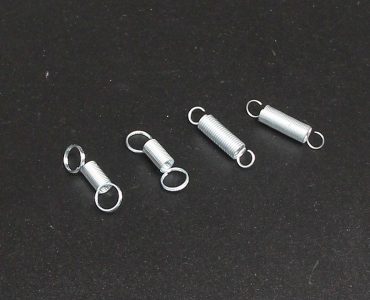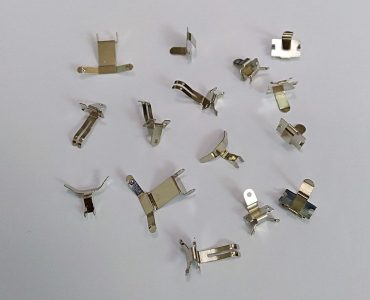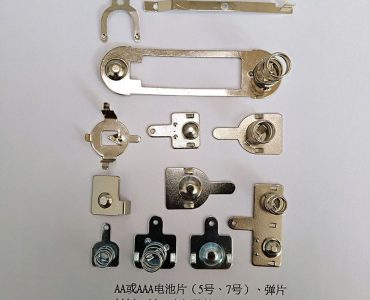What is a compression spring? Compression Encyclopedia
Compression spring is a kind of hardware fitting with spiral geometry formed by wire. Hardening and strengthening work are more difficult than flat hardware fittings.
Related standards: GB/T_1239[1].2–2009_Technical conditions for cold rolled cylindrical spiral springs, GB/T2089–94, etc.
Design and production of compression springs
1. According to the actual product demand, choose the spring material according to the standard;
2. According to the product force value, compression stroke, fatigue and other requirements, determine the value range of the compression spring’s inner and outer diameter, effective number of turns, and wire diameter;
3. Substitute relevant parameters into the design parameter formula;
4. It is more reasonable and feasible to design and produce by the spring manufacturer.
Compression spring strengthening process
Compression spring is a kind of hardware fitting with spiral geometry formed by wire, so the hardening and strengthening work for it is more difficult than flat hardware fittings (such as stamping parts).
compressed spring
It is more difficult. In addition, it is necessary to strictly control the hardening effect of the cross section of the compression spring, so as to fully understand the resistance of the compression spring to fatigue fracture after use.
Pressure spring hardening generally adopts two methods: shot peening hardening and heat treatment hardening.
Shot blasting and hard compression spring treatment: To process a batch of compression springs, the compression springs can be transported to the shot blasting room one by one by a separate conveyor belt. The shot blasting city is equipped with a set of parallel roller channels, which are strengthened while being rolled to drive the pressure. The spring edge rotates forward. This way of rotation allows the high-speed pill flow to pass through the middle of the various coils of the compression spring and hit the metal surface of the inner circle. That happens to be the most concentrated part of the compression spring. Shot peening is the most concentrated spring. With a good strengthening method, the fatigue life of high-stress springs can be increased by more than 4 times after proper shot peening.
Heat treatment and hardening of compression spring:
1. Compression spring working conditions and material and heat treatment requirements
1.Conditions: simple shape, small cross-section, spring with little force
Requirements: 65 785-815℃ oil quenching, 300℃400℃, 500℃. Tempered at 600°C, the corresponding hardness is HB512, HB430, HB369, 75, 780-800°C oil or water quenching, tempered at 400-420°C, HRC42-48.
2. Condition: Large spring with medium load
Requirements: 60Si2MnA65Mn 870℃ oil quenching, 460℃ tempering, HRC40-45 (agricultural machinery seat spring 65Mn quenching and tempering HB280-370)
3. Conditions: large leaf springs and coil springs with heavy load, high spring, high fatigue limit
Requirements: 50CrVA, 60SiMnA 860℃ oil quenching, 475℃ tempering, HRC40-45
4. Condition: A coil spring with a diameter of 8-10mm working under multiple alternating loads
Requirements: 50CrMnA840-870℃ oil quenching, 450-480℃ tempering, HB387-418
5. Conditions: locomotive, vehicle, coal water truck or leaf spring
Requirements: 55SiMn, 60Si2Mn HRC39-45 (hb363-432) (Jiefang car leaf spring: 55Si2Mn HB363-441)
6. Conditions: Vehicle and buffer coil spring, automobile tension spring
Requirements: 55Si2Mn, 60Si2Mn, 60Si2CrA quenched, tempered, HRC40-47 or HB370-441
7. Conditions: Diesel pump plunger springs, fuel injector springs, agricultural diesel engine valve springs and valve springs and leaf springs for medium- and heavy-duty vehicles
Requirements: 50CrVA quenching, tempering, HRC40-47
8.Conditions: coil springs and flat springs working under high temperature steam, tap water pipe springs and seawater corrosion resistant springs, Φ10-25mm
Requirements: 3Cr13HRC39-46 4Cr13 HRC48-50 HRC48-49 HRC47-49 HRC37-40 HRC31-35 HRC33-47
9. Condition: spring working in acid-base medium
Requirements: 2Cr18Ni91100-1150℃ water quenching, stress relief after winding, tempering at 400℃ for 60min, HB160-200
10. Conditions: circlip δ4, Φ85
Requirements: 60Si2 400℃ preheating, 860℃ oil quenching, 430℃ tempering and air cooling, HRC40-45.
2. Compression spring remarks
1. Spring heat treatment generally requires hardening, fine grains, and less retained austenite. The depth of the decarburization layer on each side should meet: <Φ6mm steel wire or steel plate, should be Φ6mm steel wire steel plate, should be <1.0% of the diameter or thickness.
2. The large spring is processed and formed in the hot state and then quenched and tempered, and the medium spring is processed and formed in the cold state (the raw material requires spheroidization or most of the spheroidization), and then quenched and tempered. Small springs use cold rolled steel strip, cold After cold processing such as drawing wire, tempering at low temperature
3. After treatment, it can be shot peening:
40-50N/cm2 compressed air or centrifuge 70m/s linear speed, Φ0.3-0.5mm (for small parts, valve springs, gears, etc.), Φ0.6-0.8mm (for leaf springs, crankshafts, etc.) , Half shaft, etc.) Cast iron shots or hardened steel shots are sprayed onto the surface of the spring to strengthen the surface. The number of fatigue cycles can be increased by 8-13 times, and the service life can be increased by more than 2-2.5 times.
Compression spring specification code
Compression spring is a more versatile hardware accessory.
A name—B dimensional accuracy and direction of rotation—C standard number—D material number—E surface treatment
A name: Compression spring
B dimension accuracy and direction of rotation: d×D2×H0—accuracy direction of rotation
C standard number: GB2089-80
Note: If the spring rotation is left-handed, it should be noted, but right-handed should not be noted.
When it is required to check the inner diameter of the spring, add the symbol “D1” after the value of D2.
Marking example: material diameter 1.2mm, spring middle diameter 8mm, free height 40mm, accuracy of load, outer diameter, free height and the perpendicularity of axis line and both ends of the ring is level 2, the material is carbon spring steel wire group IIa, the surface is plated Zinc-treated left-handed spring;
Compression spring 1.2×8×40-2 left GB2089-80·Ⅱa-D·Zn.
The material diameter is 3mm, the spring diameter is 20mm, and the free height is 80mm. The accuracy of the load, inner diameter, free height and the perpendicularity of the axis line and the two ends of the ring is level 3. The material is carbon spring steel wire group Ⅱ, surface oxidation treatment of right-handed spring ;
Compression spring 3×20D1×80 GB2089-80.
Compression spring design parameters
Necessary information for compression spring:
(1) Controlling diameter of compression spring (a) outer diameter, (b) inner diameter, installation guarantee size (c) inner diameter of the casing, (d) outer diameter of the rod.
(2) Wire or bar size.
(3) Material (type and grade).
(4) Number of laps: (a) the total number of laps and (b) right-hand or left-hand.
(5) Style of ends.
(6) Load under a certain length of torsion zone.
(7) The load ratio within the range of length from one inch to several inches.
(8) “Maximum solid height” (Maximum solid height).
(9) The minimum compression height during use.
Please specify the compression spring drawing: material diameter (d), outer diameter (D) free height (Ho) total turns (n 1 ), number of working turns (n), pitch (t), spiral direction: there is left-right rotation Points, usually right-handed, generally right-handed if not specified in the drawing. If there is a load, the load (p 1 p 2…… pi) and the corresponding value (H1H2……Hj) or (F1F2……Fj) are required.
Compression spring characteristics
Compression spring is a helical spring that bears axial pressure. Because it can bear pressure, the two ends can be open or closed or flattened or ground. The cross-section of the material used is mostly round, but also rectangular and multi-stranded steel. Rolled springs have equal and variable pitches. The shapes of compression springs are: cylindrical, conical, convex and concave, as well as a small number of non-circular and even various tail end variants. The product needs to be shaped according to the design, etc. There is a certain gap between the ring and the ring of the compression spring. When the spring is subjected to an external load, the spring shrinks and deforms to store the deformation energy.
Compression spring application
Compression spring, compression spring (Compression Spring) is the most widely used one of all types of springs. The products are widely used in electronics, motors, computers, information, automobiles and motorcycles, bicycles, hardware tools, gifts, toys, and even the defense industry. , Because its design and principle are easy to master, manufacturing control is also the simplest.




